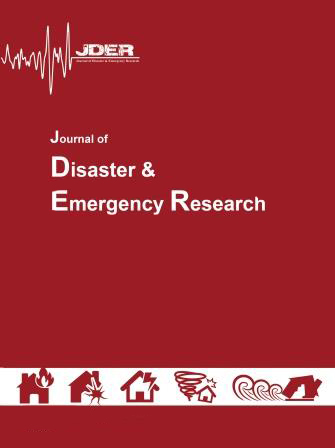Document Type : Letter to The Editor
Authors
1 1. Social Development and Health Promotion Research Center, Gonabad University of Medical Sciences, Gonabad, Iran 2. National Medical Emergency Organization, Ministry of Health & medical education, Tehran, Iran
2 Health Management and Economics Research Center, Health Management Research Institute, Iran University of Medical Sciences, Tehran, Iran
Abstract
No Abstract
Keywords
Dear Editor,
Helicopter Emergency Medical Services (HEMS) have been developed to provide acute medical care outside hospital. One of these acute situations is Out of Hospital Cardiac Arrest (OHCA) (1). The rate of Cardiopulmonary Resuscitation (CPR) attempted in patients with OHCA is estimated to be 56 per 100000 people per year in the European Registry of Cardiac Arrest (2). In Iran, acute coronary syndrome and cardiac arrest, respectively, account for 10%
and 6% of the indications for helicopter dispatch (3).
OHCA is one of the major causes of air ambulance call-out. In fact, it is the leading cause of mortality and serious neurological impact. High-quality services for continuous chest compression are crucial in patients who need to receive these services. Moreover, interruptions of CPR can significantly reduce survival rates in these victims (4). In Poland, the mean survival rate of transport by HEMS is reported to be 36/3%. One of the factors related to the survival of patients transferred by HEMS concerns procedures performed by the HEMS personnel (2). One of the main procedures is CPR during emergency helicopter flights.
The main challenge in a modern emergency helicopter is the small layout of cabin for the HEMS crew and patient during the CPR. In this tiny cabin, without Mechanical Chest Compression Devices (MCDs), continuous chest compression during transport would be impractical, (5). In Fact, it is barely possible, and often of poor quality, during emergency helicopter flights. These conditions are completely different in the ground ambulance: first, the space and height of the ground ambulance cabin are suitable for the resuscitation process, and second, it is possible to stop the ground ambulance during patient transfer.
In this regard, MCDs are used worldwide in many countries. In many European countries such as Italy, Switzerland, Germany and Australia, Mechanical Cardiopulmonary Resuscitation (M-CPR) has been increasingly used in the HEMS setting (4). Also, literature indicates that the use of various MCDs in Emergency Medical Services (EMS) and HEMS have been effective in improving the survival of patients during OHCA (4, 6).
Furthermore, using MCDs can increase the effectiveness of CPR. Another advantage of using these devices is the reduction of heavy workload of HEMS caregivers. In addition, these devices improve mental and cognitive performance of the HEMS staff during helicopter flight (7).
The resuscitation process, itself, is a stressful condition and requires multiple interventions. Moreover, it should be noted that the medical flight crew member has other significant responsibilities during the flight, in addition to the provision of medical emergency services. These include communication and coordination with the pilot and emergency communications center, application of drugs and defibrillation, completing Pre-hospital Care Report (PCR) online, and other medical procedures. Consequently, the availability of such devices can be considered an option for increasing the quality of HEMS.
In conclusion, considering the development of HEMS in the last decade in Iran, it is highly recommended to equip emergency helicopters with MCDs, to deal with OHCA in transporting patients.
Acknowledgments
Not applicable.
Funding source
No funding source was allocated to this study.
Conflict of Interest
The authors declared no conflict of interest.
Authors' contribution
All authors contributed to this project and article equally. All authors read and approved the final manuscript.
Abbreviations
HEMS: Helicopter Emergency Medical Services
OHCA: Out-of-Hospital Cardiac Arrest
CPR: Cardiopulmonary Resuscitation
MCDs: Mechanical Chest Compression Devices
M-CPR: Mechanical Cardiopulmonary Resuscitation
EMS: Emergency Medical Services
- Berkeveld E, Sierkstra TCN, Schober P, et al. Characteristics of helicopter emergency medical services (HEMS) dispatch cancellations during a six-year period in a Dutch HEMS region. BMC Emerg Med. 2021; 21(1): 50.
- Nadolny K, Zyśko D, Obremska M, et al. Analysis of out-of-hospital cardiac arrest in Poland in a 1-year period: data from the POL-OHCA registry. Kardiol Pol. 2020; 78(5): 404-11.
- Sajjadi SM, Koushkaki FR, Mousavi-Roknabadi RS, et al. Transferred Patients by Fars Province’s Helicopter Emergency Medical Service (HEMS); A 2-Years Cross-Sectional Study in Southern Iran. Bulletin of Emergency & Trauma. 2021; 9(1): 21. [Persian]
- Pietsch U, Reiser D, Wenzel V, et al. Mechanical chest compression devices in the helicopter emergency medical service in Switzerland. Scand J Trauma Resusc Emerg Med. 2020; 28(1): 71.
- Coggins AR, Nottingham C, Byth K, et al. Randomised controlled trial of simulation-based education for mechanical cardiopulmonary resuscitation training. Emergency Medicine Journal. 2019; 36(5): 266-72.
- Alexander E, Katharina T, Verena F, et al. Comparison of different mechanical chest compression devices in the alpine rescue setting: a randomized triple crossover experiment. Scandinavian Journal of Trauma, Resuscitation and Emergency Medicine. 2021; 29(1): 1-8.
- Rehatschek G, Muench M, Schenk I, et al. Mechanical LUCAS resuscitation is effective, reduces physical workload and improves mental performance of helicopter teams. Minerva Anestesiol. 2016; 82(4): 429-37.

